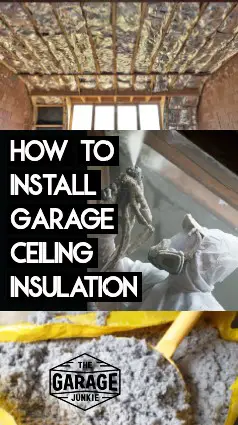Making your garage a workable space during the more extreme climates of the year is not normally a one and done process. In my experience, the most effective route will involve a three-fold process. First, stopping heat and cold from coming in or escaping. Second, being able to circulate the air in your garage. And third, finding a way to warm or cool your working space as needed.

There is an old saying about accomplishing large tasks like this one. The question is posed, “How do you eat an elephant?” (Or in this case, “How do you make your garage useable in the summer or winter?”) The answer: “One bite at a time,” or more like, “One improvement at a time.”
To begin tackling this project for garage temperature control, one of the “big impact” places to start is the garage ceiling. As heat rises and escapes, the ceiling is the first place to address when trying to keep your garage warm in the winter. Along the same lines, since your house roof continually has the sun’s rays beating down during the summer, the attic above the garage ceiling can heat up exponentially and transfer that heat into the garage itself. Adding insulation to your garage ceiling is an excellent place to start with temperature control in your garage.
Adding insulation to your garage ceiling is an upgrade that can help lower energy bills, dampen sound and even out the temperatures during the heat of the summer and chill of the winter. There are a handful of types to choose from depending on your attic space and DIY prowess. Each different kind of insulation has its own steps for installation. The following is a quick guide for installing each type and the different benefits they can bring to the space above your garage.

Scope Out the Attic for Your Garage Ceiling Insulation
Before you being to install garage ceiling insulation, you need to take a look in the attic over your garage to see what you have to work with. Generally, you will see trusses and drywall screwed up under the ceiling joists, but that is not always the case.
Here are a few things to pay specific attention to before you install garage ceiling insulation:
How much space do you have to work?
If the garage attic is cramped for space, you might want to consider blown in insulation over the other options. The blower machine will be able to get into the nooks and crannies that your lacking ninja skills might struggle with as you try to lay down batts.
Do you store items about your garage attic space?
If you use your attic as storage, easy accessing your items will be a must. In this case, batt insulation may be for you. This can be laid down between the trusses and have shelving built over the joists. For added temperature control, spray foam insulation can be added between the top chords on the attic ceiling, making it more storage-friendly.
Do you have any plans for your garage that would require attic access?
Aside from storage, there are occasionally other upgrades that will require some crawling around in the attic. For example, if you plan to run electrical for a ceiling fan or some shop lights, you will need to be able to access the drywall above your garage. Different types of insulation will give you the kind of access you need or can become a hindrance if you didn’t plan ahead.
Batt insulation is a good choice because you are able to lift up and roll the batts back in place as you carry on with your projects. It takes little time to move and place the batting back once you are complete. It also keeps cleanup from disturbing the insulation to a minimum. Cellulose, on the other hand, as it is blown in and designed to be permanent, will not give you access to the ceiling after it is installed.
Spray foam insulation is another great choice if there are other projects that need to be done in the ceiling itself. As mentioned before, this type of insulation runs along the roofline and out of the way of the trusses and framing directly above the ceiling. We will talk more about the benefits and uses of each type in the next section.
Different Types of Insulation to Use for Your Garage Ceiling
After you’ve answered some basic questions about your attic, it’s time to choose which type of insulation will best suit your needs. In general, you may want to consider the ease of installation, the overall cost, and, again, what kind of attic access you may need in the future.
Type #1: Cellulose – Spray–in Paper
Cellulose is a loose material that is made from recycled paper or, in some cases, recycled denim. It can be densely packed in to attic ceilings, or it can be mixed with water and sprayed in place on to ceilings and walls. The spray installation process is messy, but with the right tools it can be completed as a two-man job in just a few hours.
For the spray-in type, you will need to purchase the cellulose itself, rent a spray machine, and find a friend to feed the hopper while you spray in the insulation.
For this type of garage ceiling insulation to be most effective, you will also need to determine a “depth” to spray the cellulose to. The thickness of the spray will determine the R-value that you are trying to obtain. Once you fire up the spray machine, making sure the coat is even will be the name of the game. The cellulose will build on itself as you spray until the desired depth is achieved.
To help you with this, there are products, that you can install prior to your insulation escapades so you do not have to eye how thick of a layer of insulation you are adding is.
Cellulose is probably one of the most cost-effective types of insulation you can install in your garage ceiling. And, if you don’t need attic access for things like storage or running wiring, this may be the best option for you.
Type #2: Batt insulation
Batt insulation is the most “cut and dry” when it comes to installing garage ceiling insulation. Typically made of fiberglass or cotton, sometimes with a paper backing, this type of insulation can be purchased in large rolls and cut to fit the space you want to insulate. Once the pieces are cut to size, installation is fairly straight-forward. Lay the insulation pieces between the chords with the barrier facing down, and staple the flaps on either side of the barrier between the joists.
Batt insulation takes the guessing game out of installing garage ceiling insulation. When you decide to go with this type of insulation, you determine the thickness you have space for, and you install the insulation. There are no uneven areas like cellulose and as long as you wear the proper PPE (Personal Protective Equipment), it requires less cleanup than many other options you might be considering.
Batt insulation is also affordable, as it is a common construction material that can be purchased at nearly any home improvement store. Again, if there are future electrical plans in store for your ceiling this material is the way to go, as it can be moved aside and replaced without much trouble.
Type #3: Mineral Wool Insulation
Another specialized type of batt insulation is called mineral wool. This material is made from spun molten rock and has great insulative and sound dampening properties. Just like the fiberglass, mineral wool comes in batts or rolls and can be cut to size and installed by simply laying it between the joists in the attic.
It may sound similar to fiberglass, but there are a few differences to check out. For one thing, mineral wool is denser than fiberglass, making the batts slightly more rigid for a snug fit between the ceiling joists. I also personally like that this material is less irritating to the skin than other types of insulation. It is also extremely easy to cut and is simple to work around obstacles. For electrical lines or pipes, all you need to do is score the insulation batt and fit the batt around the electrical or plumbing.
Mineral wool is one of the more expensive types of insulation we’ve listed here. However, depending on your situation, the benefits may outweigh the cost. For quality, sometimes the investment is it in the long-run.
Type #4: Spray Foam Insulation
A final option to consider for garage ceiling insulation is spray foam insulation. While this type can be done as a DIY project, it is more common for a professional to install as there is some technique involved in applying it correctly. The benefits may be worth every dollar you spend, though, if garage temperature control is a high priority for you.
Personal story: when we were having our new house constructed, we had the contractor use spray insulation above the ceiling in the living areas of the home. The spray foam was added between the upper chords of the truss and against the roof sheeting. I can’t tell you the wonderful, unexpected surprise our first summer electrical bill was! The insulation made a noticeable difference.
Having the insulation overhead rather than laying on the joists when you are working in the attic not only makes it easier if you are installing an additional light fixture or running a new cable, but it also makes the area much more pleasant to work in. For example, rather than on a 115-degree day out here in the desert, with an attic temperature of 140+. With the insulation above the attic space, if the house is set to 78-degrees, the attic might be 85.
Final Thoughts
Any upgrade to your home or garage will take some initial decision-making and will benefit from informed execution. If you want the job to be done well, and to best suit your budget and your needs, research is needed. We hope this article has compiled some initial information to get you started on your journey into creating a more comfortable garage space.
